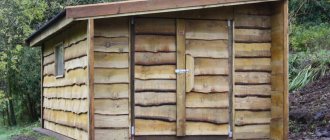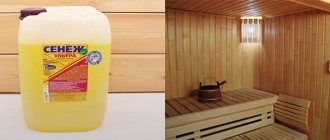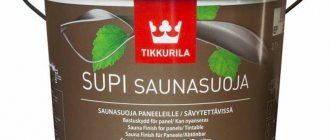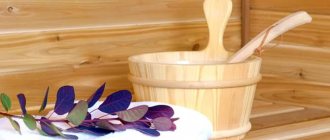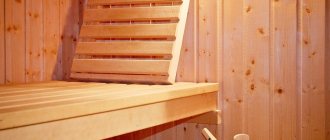Bathhouse owners often have disputes about the need for a special product intended exclusively for washing bathhouses and saunas. Most believe that the usual universal methods of home care will do, but some believe that the presence of a specialized product is mandatory.
In Russia, baths, as a rule, are of a slightly different nature than in other countries. We have a lot of them, and in villages this is generally a common phenomenon, since next to every residential house there is an equally beautiful bathhouse. However, in our case, these establishments are intended for individual use, maximum for a family, but in other countries bathhouses are public institutions. Therefore, the availability of a safe bath detergent is quite in demand among the population.
What surfaces is the product intended for? Yes, for everyone you can imagine. With its help you can process wooden walls and floors, tiles, glass elements and much more. From this, a wide range of applications can be defined.
Materials and tools for work
To remove various types of contaminants, including soap scum, soot, soot, and mold, you need to stock up on special tools and materials that will help with processing. The list of these includes:
- hard brushes and sponges with no abrasive;
- cycle of sufficient sharpening;
- medium and fine grit sandpaper;
- foam sponges with long handles and washcloths;
- soft rags (preferably not synthetic), cotton and terry cloth are suitable;
- buckets, basins, water containers;
- disinfectant composition (the best cheap alternative is “Belizna” or any chlorine-containing composition);
- broom, mop with microfiber attachment;
- stepladder or stable chairs to reach the highest point for cleaning);
- liquid household chemicals, soap, sprays (a degreaser for stoves is suitable), means for internal cleaning of the firebox and chimney duct, oils for impregnation;
- personal protective equipment (mask, respirator, gloves, apron)
Steaming surfaces in a steam room Source archiwum.allegro.pl
Why does the chimney become dirty?
How to clean a chimney in a bathhouse depends on the nature of the contamination. With use, types of clogging may occur such as:
- soot and soot, which accumulates very quickly when burning household waste;
- condensation that forms due to irregular use of the bathhouse;
- foreign objects accidentally falling into the chimney.
All of these types of contaminants ultimately impede the free circulation of air and the escape of smoke through the chimney.
This may cause carbon monoxide poisoning. Condensate is a weakly concentrated acid solution. Under its influence, the chimney masonry begins to collapse from resinous deposits. If you use a sauna regularly, you need to make a schedule and determine in advance when and how to clean the pipe in the sauna. Carrying out such work regularly will preserve the chimney and stove and allow you to use the sauna without any problems.
Preparatory stage
Before you start washing the surfaces in the steam room, you must first prepare everything. This process consists of several standard steps:
- Removing items, stools, bath furniture (if available) and other accessories for the steam room (panama hats, brooms, soap compositions). It is important to exclude all objects that may interfere with cleaning.
- Removing cobwebs from ceilings, sweeping dust off walls, removing leftover leaves from brooms and other debris from shelves.
- Cleaning the stove (if its firebox is located directly in the steam room), ash and other combustion products are completely removed from it.
- Sweeping the floor, if necessary, pre-wash it with liquid soap (soap or a special composition for wooden floors).
After the above steps are completed, you can begin processing the internal surfaces.
On a note! When choosing cleaning products, remember that they should not harm the wood from which the bathhouse is made.
Why do you need to wash the inside of the bathhouse?
Every time after visiting the bathhouse, dirt remains in the room. The drain becomes clogged with debris and bath leaves, and soapy water spreads over the surfaces, forming an unsightly residue. Germs and bacteria multiply, resulting in an unpleasant odor.
And this is only after a couple of visits to the steam room. But what should the owners of purchased bathhouses do, who are wondering: how to clean the inside of the bathhouse after the old owners?
Over time, the ceiling becomes smoky and the walls require cleaning. Soot, soot and moisture accumulate in the chimney, which can lead to a fire hazard or carbon monoxide poisoning.
Scale accumulates on the bottom and walls inside the tank. Its cause is hard tap water.
In the steam room, particles of used brooms, aromatic herbs, and steams poured on stones settle on the shelves and walls. Wooden surfaces lose their natural color and darken.
If you do not systematically clean all the elements of the interior of the bathhouse, mold will grow in it, the wooden coverings will become deformed, and ultimately you will have to do major repairs. But knowing what to clean the bathhouse with, you can only get by with general cleaning.
Ceiling cleaning
After a long period of use of the steam room, fungus and mold often appear on the ceiling surface, and the coating turns black. You can get rid of these consequences using simple folk remedies.
Clean ceiling in the steam room Source par-torg.com
Copper sulfate solution
Copper sulfate itself is a powerful antiseptic; it not only disinfects, but also prevents the further development of dangerous fungal microorganisms on wood. To prepare a detergent based on vitriol, do the following:
- take 50 grams of copper sulfate and dissolve it in 10 liters of water;
- make sure that each crystal of the product is converted into a liquid composition;
- soak a soft foam sponge in the product, stand on the stairs and carefully treat the ceiling surface;
- Wash areas with large accumulations of mold (corners, crevices between wood) with this mixture twice or three times;
- After treatment, apply detergent to the same sponge (liquid laundry or regular soap is suitable), foam it well and wash the ceilings again.
After cleaning, be sure to rinse everything off with clean water.
Copper sulfate solution for cleaning surfaces in a bath Source infourok.ru
What should you consider when choosing?
The market is rich in bath products, so there are certain points that you should pay attention to when purchasing a safe bath detergent . This will allow you to choose the best quality model and have a more visible result based on the results of your work. Look who the manufacturer is (foreign countries or Russia). In the first case, the quality will be higher, but, accordingly, the price will be higher. Often it is hyped up only because of a well-known brand. So, maybe it’s worth supporting domestic companies? The cost will be several times lower. Just before doing this, you should turn to the Internet to determine how worthy this product will be. Next you need to decide what kind of mixture you need.
- Target:
— disinfection – antiseptics;
- lowering the level of flammability - fire retardant composition;
– protection from insects and rot – bioprotective agents;
- normal cleaning - detergents.
- Processing type:
- from the street - external treatment;
— from the inside – internal processing.
- Type of material:
- wood;
- glass;
- stone;
- tiles, etc.
Proper care and operation in compliance with the simplest rules will significantly increase the life of the sauna, increasing it by ten years or more.
Video description
Bathhouse like new after cleaning
Budget "Whiteness"
“Whiteness” contains chlorine in its composition, therefore it is also an excellent disinfectant, but it must be used with caution, as it can discolor surfaces. To prepare the cleaning product, do the following:
- prepare 25 milliliters of alcohol, bleach, diluted copper sulfate, “Whiteness” and 25 percent formaldehyde.
- prepare one liter of water and add to it all the ingredients listed in the first paragraph;
- be sure to choose a metal container for mixing (you can use an enamel container), then take a clean sponge or rag and soak it in the prepared mixture;
- Thoroughly wipe off all dirt with the solution, then rinse. Under no circumstances leave this composition on the ceiling until completely dry. This can cause stains that cannot be removed later.
These are the easiest ways to remove dirt from the ceiling using budget funds.
White for cleaning bath surfaces Source skladupakovki.ru
Purchase method
Special-purpose sauna chemicals can be purchased in the traditional way - bought in a store. Or you can order online. There are many sites, one of the directions of which is the sale of safe bath detergent . By choosing the latter method, you will save your time, and perhaps even your money. But in the store you can directly get acquainted with the product, evaluate the integrity of the packaging, you won’t have to wait long for the moment when you can put the purchased product into use, evaluate the effectiveness and result.(
Cleaning walls with alternative folk remedies
In this case, compounds that are available at home are also used. You can use one of the three recipe options below.
Application of acetylsalicylic acid
- To prepare the cleaning product, take a half-liter jar and pour boiling water into it to the top.
- Grind one aspirin tablet (it contains 500 mg of acid), place it in water and dissolve thoroughly so that there are no grains.
- Then let the solution cool slightly, then soak a sponge in it generously and apply the product to the surface of the wall.
- Moisten so that the solution thoroughly saturates the top layers of wood. Leave for 15 minutes for the reaction to occur.
- Afterwards, take an enamel basin and fill it with clean water, take a soft metal dish scraper and, soaking it in water, rinse the treated wall surface.
- Rinse again with water to finally get rid of dirty stains. Leave the surface to dry completely.
The result is a fairly light wall while maintaining the wood grain.
Aspirin acid for cleaning wooden surfaces in a bath Source otnogi.ru
Use of citric acid
- Fill a glass container with half a liter of boiling water, then pour 25 g of citric acid (a bag) into the water and dissolve the crystals well.
- Then, using a sponge, apply this composition to the surface of the wall and leave for 15-20 minutes. The solution must penetrate into the pores of the wood.
- The next step is to rinse the solution with warm, clean water using the abrasive side of the sponge, just do not overdo it, the top layer of wood cannot be damaged.
- Leave until completely dry, after which you can continue using the sauna room. The cleaning effect is quite good.
How to clean a chimney
The chimney and pipe in the bathhouse are cleaned chemically and/or mechanically. In a special store you can purchase liquids and/or powders for cleaning the chimney. Detailed instructions are printed on the packaging. After reading it, it will become clear how to clean a pipe in a bathhouse.
A good answer to the question of how to clean soot in a bathhouse that has accumulated in a chimney would be a “log chimney sweep.” It is impregnated with special chemicals. During combustion in the furnace, smoke of a special composition is released. As a result, the soot becomes soft and pliable. After 2 or 3 days it can be removed with brushes without much difficulty.
For mechanical cleaning of the chimney you will need the following tools and devices:
- rope and/or rope;
- weight (ball);
- brush-ruff (preferably on a thin metal cable).
First you need to check the safety of the structure. Then you need to remove any objects that accidentally got into them from the pipe and chimney. For this purpose, a brush-ruff is used, selected according to the size and shape of the pipe.
A special modern brush will make cleaning work easier. It comes with a handle consisting of several links. This allows you to adjust the length of the brush as needed. During cleaning work, any brush must be moved inside the pipe, gradually moving it lower and lower.
Such work must be performed in a special set of clothing, which must include:
- overalls or suit;
- respirator;
- gloves;
- protective glasses.
If the chimney is not very dirty, you can call a specialist. He will clean it using a special high-power vacuum cleaner. This will remove soot from the chimney through the firebox opening. The use of special means will help resolve the issue of how to clean the chimney of contaminants and how to clean the pipe of soot in a bathhouse.
Video description
Wood bleaching for 30 rubles.
Note! The use of scrapers and abrasives is permitted only if the walls in the bathhouse are not covered with a special paint and varnish material. Otherwise, you risk damaging it, after which the wood will get dirty more often and more severely.
Citric acid for cleaning wood surfaces in a steam room Source proba-luxe.ru
A mixture of soda and laundry soap
- To prepare the cleaning product, you will need 100 grams of 72 percent laundry soap, 100 ml of hot water and 75 grams of baking soda.
- Grate a bar of soap into a plastic bowl and pour hot water. Then whisk the soap shavings until all the pieces are completely dissolved.
- To do this, you can use a fork, whisk, or even a kitchen mixer. Beat the product until smooth and form an airy foam.
- If the mixture is the consistency of sour cream, add a little more water and continue whisking.
- Then add baking soda to the mixture and mix everything thoroughly again. After preparing the product, you can use it immediately.
- Apply the composition to the surface of the wall and thoroughly rub it into the wood, leave the foam on the coating for 15-20 minutes, and then rinse thoroughly with water.
Cleaning the tank
Due to the hardness of tap water, the question periodically arises of how to clean the tank in a bathhouse from scale that settles on the walls and bottom. Since scale is formed from lime deposits, it must be cleaned with acid.
Acid can only be used of organic origin. For example, lemon or vinegar. Any inorganic acid is unsafe for the metal from which the tank is made. It should be remembered that the amount of acid used to clean the tank should approximately correspond in weight to the amount of lime deposits on the walls of the heating tank.
On a note! Installing a special filter at the inlet will help prevent the formation of large amounts of scale.
The water passing through it will be purified from a significant amount of impurities. This will greatly reduce the level of scale formation.
Floor cleaning
It is recommended to wash wooden floors exclusively using a special wood treatment product. It is allowed to use the same “Whiteness” or Domestos. In addition to this, ammonia is also used. To clean the floor, the sequence of actions will be as follows:
- prepare a soft rag, cloth mop, wood detergent, warm water, broom, brush;
- then remove debris and dust from the floor with a broom; brushes can be used for hard-to-reach places;
- Take a tablespoon of baking soda, pour it into a bucket of warm water, and then add wood floor cleaner (see instructions for quantities). Instead of soda, you can add a bottle of ammonia;
- soak a rag or mop in the prepared solution, and then wring it out thoroughly. Wipe the entire floor well so that there are no streaks or drops of water;
- If there is no protective coating on the wooden floor, it should be washed with a barely damp cloth, and then wiped dry with a towel or rag.
Next, you can rub the boards with polish or special impregnations so that the dirt is less absorbed.
Using a cycle to clean the floor in a bathhouse Source stroydachusam.ru
If the floors are too dirty and simple washing does not help, it is recommended to strip the top layer of wood. To do this, it is scraped off with a plane to 2-3 mm, and then sanded with a machine.
On a note! If the floor is heavily soiled, the boards are removed and sanded separately, and if necessary, simply replaced with new ones.
How and when to use your chosen bath detergent?
Compliance with the rules that are reflected in the instructions for the purchased product is the key to the highest degree of safety of the work process, as well as the effectiveness of the manipulations performed. It is necessary to follow the technology of surface treatment so that the result is truly what you are counting on at the beginning. Please note that cleaning a sauna is possible at two stages: during construction (preventative purpose), during the period of operation of the sauna (“treatment” of contaminated wood). Prevention is always better than treatment, because it is ahead of the development of problems.
During the construction period, the steam room is completely processed (all logs, boards that are used in construction). This is done for the following purposes: to prevent destruction of the tree cover by insects, fire, and other phenomena. One of the many bonuses of such an event is the extension of service life by seven years. Of course, these figures are arbitrary, but proper care will ensure a long operational period.
An already constructed building is subject to periodic maintenance. The product you purchase will help improve your condition . The market is replete with such goods. But you should choose a safe bath detergent.
Processing shelves and benches
To clean shelves and benches in a bathhouse, you can use a scrubber, which will not only remove stubborn stains, but also remove the top layer of wood. Therefore, after cleaning, be sure to open the wood with a protective compound. It is just important to avoid applying varnish, as it gets very hot and can cause burns when using the steam room.
The ideal way to remove all stains of grease and sweat on benches in a bathhouse is to use a Karcher mini-wash or a device from another company. Under high pressure, it delivers a stream of water mixed with air and removes everything, even the most difficult stains. You can add ammonia to the washer dispenser to enhance the effect. Subsequent use of a steam cleaner is also allowed.
Clean shelves in the bathroom after treatment Source na-dache.pro
It’s just important to control the distance of the nozzle to the shelves: if you bring it too close, you risk not only getting rid of stains, but also making a hole in the wood. This defect can only be corrected by replacing the board.
General principles for carrying out disinfection activities
Disinfection is a comprehensive set of measures aimed at destroying pathogens of infectious diseases and destroying toxins in the external environment of a bathhouse and individual bathing items.
It is worth understanding that in some cases, disinfection measures cannot completely destroy the pathogen. Then the minimum task is the need to reduce their concentration to the threshold of the infectious dose, that is, such a number of pathogens that, upon contact with the surface of a person’s skin or mucous membranes, are not able to initiate the disease.
Important! Microbiologists say that a temperature of 60 degrees Celsius is destructive for most types of microorganisms. As a result of exposure to high temperature, a sterilization process occurs, during which the enzyme systems of the cell are destroyed and damaged, and irreversible coagulation of its protoplasm occurs. Proteins of extracellular forms of pathogens, for example, the lipid membranes of viruses, also coagulate under such conditions. However, bacterial spores can withstand significantly higher temperatures, and not for a short time, but up to several hours. The thermal stability of spores is especially pronounced when thermal exposure occurs in viscous media and water vapor is significantly diluted with air.
Disinfection can be of the following types:
- Preventative - when the sauna room is treated proactively, that is, there are no signs of pathogens and the sanitary situation in the sauna is quite good. Prevention is always aimed at eliminating a possible cause, and not at dealing with the consequences that have occurred.
- Current - is carried out with the aim of localizing and eliminating the identified source of infection.
Disinfection methods
Carrying out disinfection in various ways is based on objective possibilities and specific local conditions. The list of disinfection methods includes the following:
- Mechanical - consists of removing and disposing of the surface contaminated layer from shelves, benches, chairs and other things. To carry it out, scrapers, wide-bladed knives, sharpened spatulas, drifts, etc. are used. The most labor-intensive and unsafe method, which involves prolonged contact with an infected environment directly during the work. Indeed, dry and wet cleaning, removing dust from bath curtains, linens, brooms, painting and whitewashing rooms are not the most pleasant procedures;
- Physical - involves the use of influence on the surface populated by pathogens of various factors of a physical nature. For example, high temperature, harsh ultraviolet radiation, open flame, etc.;
- Chemical - characterizes the effect on colonies of microorganisms of various chemicals that are harmful to them. During chemical treatment, as with other methods, not only microorganisms are directly exposed, but the toxins they produce are also deactivated;
- Biological - at its core, contains the principle of a derogatory effect on the pathogen of an antagonistic microorganism, which in itself does not pose a threat to humans. In bath practice, this method, for a number of objective reasons, has not found application;
- Comprehensive - contains a combination of the above methods, as a result of which it is possible to obtain wider and better coverage and quality of disinfection measures.
By the way! Speaking about disinfection methods, it is worth mentioning such a method as treatment with sunlight. Direct sunlight works quite effectively and versatilely. On the one hand, the infection is affected by ultraviolet rays, which slow down metabolism and destroy the cellular structure of infections that are bacterial in nature. On the other hand, there is exposure to light waves having a length of about 320-400 nm, which initiate free oxygen radicals and hydrogen peroxide, which also have a detrimental effect on microorganisms. This effect is especially pronounced on wet surfaces. Finally, infrared waves from the solar spectrum have a thermal effect on pathogens. It is worth understanding that it is easiest to expose household items to direct sunlight that are easy to move, so many bath attendants try to make lightweight benches, removable bath shelves, easily dismantled shower buckets, and so on.
Cleanliness in the steam room
The steam room in the bathhouse requires special attention. After all, when using brooms, particles of plant pigment from stems and/or leaves are absorbed into wooden shelves and walls along with moisture. Therefore, the question inevitably arises of how to clean the steam room in a bathhouse to give it a fresh and pleasant look.
The problem of how to clean linden lining in a bathhouse, especially in the steam room, can be solved in different ways. If the wood darkens slightly, you can use special liquid detergents and/or paraffin oil.
The cleaning liquid is applied to the darkened surfaces manually using a piece of foam rubber or a regular sponge. The pre-detergent must be diluted with water. How to do this is detailed in the instructions.
Paraffin oil is gradually applied to pre-dried surfaces using a dry sponge. In this way, you can not only clean the lining in the steam room, but also give the wood water-repellent properties. This will protect the wood trim and various items from severe and rapid contamination.
You need to know about this!
There are many facts that are interesting and educational. For example, Finns are big fans of saunas. In this state, 2 million saunas have been built for every 5 million people. This is simply amazing! Even in a multi-storey building, where it would seem impractical to build a bathhouse, it is still installed in the area of the ground floor or in the basement.
Residents of Finland love their country, as well as its ecology. They put human health in the foreground, because in the sauna you can improve your health and strengthen your body as a whole. The Finns treat sauna premises with care; they have long used all kinds of chemicals, and the Russians have learned a lot from them, having adopted the experience of caring for wooden structures.
We recommend
DOCKER MAZBIT PLUS is a concentrated product for cleaning surfaces from the effects of fire. Designed for effective quick cleaning of any surfaces (wood, concrete, plaster, stone, tiles) from various contaminations by combustion products, such as soot, soot, carbon deposits. Without smell. Does not contain chlorine or acid.
More details
How to clean soot after a fire How to remove soot from bricks How to clean soot in a bathhouse
What is wood?
Wood is classified as a natural building material that has specific properties:
- Speaking about mechanical properties, it is assumed that wood is a strong and solid material that is almost not deformed. It has excellent operational and technological qualities; this building material is able to withstand heavy loads.
- Physical properties are understood as the external data of wood (texture, color), its thermal conductivity, sound and electrical conductivity, and humidity.
- If we talk about chemical properties, it should be noted that this is a natural anisotrope, since differently oriented fibers have their own special characteristics. For example, when drying, fibers behave differently: longitudinal fibers take much longer to dry than transverse fibers. Radial fibers, in turn, dry faster than tangential fibers.
You should carefully consider the features of this building material in order to make the right choice of special protective compounds for wooden buildings and products:
- The strength of wood is the most important characteristic of the material. Thanks to it, it has the ability to resist various aggressive mechanical loads.
- To determine the hardness of wood, special tests are used, in particular the Janka test. In simpler terms, this is the degree of resistance of wood to the effects of bodies much harder than itself.
- The wear resistance of wood refers to the ability of the material and structures made from it to resist various impacts associated with operation.
- As for humidity, it can be absolute or relative.
Therefore, to decide how to treat the bathhouse inside and outside? better chemistry specifically designed for this purpose. But first you need to understand the characteristics of wood. If we talk about the operational parameters of this building material, they have a lot in common with properties, but may differ slightly in their purpose:
- Hardness and stability.
- Level of oxidation and resistance to mechanical stress.
Tree species from which various products are made, each of them has its own special physical, mechanical and chemical properties, as well as performance indicators. Naturally, the means for processing and impregnation cannot be the same. Although there are compositions that can be used for any breed. Thus, the question of funds practically disappears.


